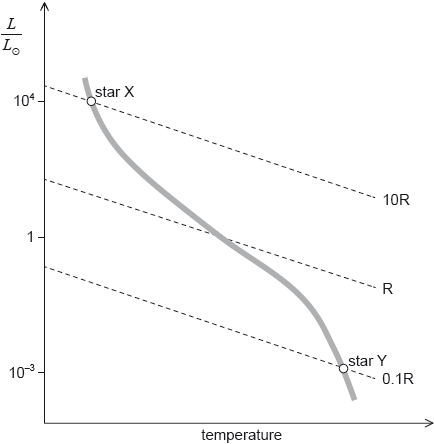| Date | November 2017 | Marks available | 2 | Reference code | 17N.3.SL.TZ0.12 |
| Level | Standard level | Paper | Paper 3 | Time zone | 0 - no time zone |
| Command term | Show | Question number | 12 | Adapted from | N/A |
Question
Sirius is a binary star. It is composed of two stars, Sirius A and Sirius B. Sirius A is a main sequence star.
The Sun’s surface temperature is about 5800 K.
The image shows a Hertzsprung–Russell (HR) diagram.
The mass of Sirius A is twice the mass of the Sun. Using the Hertzsprung–Russell (HR) diagram,
State what is meant by a binary star.
The peak spectral line of Sirius B has a measured wavelength of 115 nm. Show that the surface temperature of Sirius B is about 25 000 K.
The mass of Sirius B is about the same mass as the Sun. The luminosity of Sirius B is 2.5 % of the luminosity of the Sun. Show, with a calculation, that Sirius B is not a main sequence star.
Determine the radius of Sirius B in terms of the radius of the Sun.
Identify the star type of Sirius B.
draw the approximate positions of Sirius A, labelled A and Sirius B, labelled B.
sketch the expected evolutionary path for Sirius A.
Markscheme
two stars orbiting a common centre «of mass»
Do not accept “stars which orbit each other”
« x T = 2.9 x 10–3»
T = = 25217 «K»
use of the mass-luminosity relationship or = 1
if Sirius B is on the main sequence then = 1 «which it is not»
Conclusion is given, justification must be stated
Allow reverse argument beginning with luminosity
= 0.025
r Sirius = « =» 0.0085 r Sun
white dwarf
Sirius A on the main sequence above and to the left of the Sun AND Sirius B on white dwarf area as shown
Both positions must be labelled
Allow the position anywhere within the limits shown.
arrow goes up and right and then loops to white dwarf area


